Analysis of Regional Inequality from Sectoral Structure, Spatial Policy and Economic Development: A Case Study of Chongqing, China
Abstract
:1. Introduction
2. Materials and Methods
2.1. Study Area
2.2. Indicator and Data
2.3. Construction and Decomposition of the Gini Coefficient
2.3.1. Construction of Gini Coefficient
2.3.2. The CR of Each Sector to Gini Coefficient
2.3.3. Decomposing Gini Coefficient Based on Spaces
2.3.4. Decomposing the Increment of Gini Coefficient
3. Results
3.1. Various Gini Coefficients in Chongqing
3.2. The CR of Each Sector to RGGC
3.3. Inequality of Main Urban and Suburban Areas in Chongqing
3.4. Inequality of Five Function Areas in Chongqing
3.5. The Causes of the Change of RGGC
4. Findings and Discussions
4.1. Dynamics of Regional Inequality in Chongqing
4.2. Confirming the Key Sector to Reduce Inequality
4.3. Analysis of Spatial Policies
4.3.1. Focusing on the Inequality between the Five Function Areas
4.3.2. Evaluating the Rationality of Spatial Divisions
4.4. Economic Development Reduces Regional Inequality
4.5. Policy Suggestions
- Combined with the national strategies to develop the economy of Chongqing. The empirical results show that economic development is helpful to reduce the inequality of Chongqing effectively, thus Chongqing should develop the economy continually. China is promoting the national strategies of “the Silk Road Economic Belt and the 21st Century Maritime Silk Road” (or simply “the Belt and Road” for short) and the “Yangtze River Economic Belt”. As the municipality and national central city in the upriver of the Yangzi River, Chongqing is located in the joint of “the Belt and Road” and the “Yangtze River Economic Belt”, which has the unique advantages of linking the east to the west and connecting the south to the north. Based on the advantages and opportunities, Chongqing should take the initiative to merge itself into national strategies, as well make the best of its own resources and national policies to develop.
- Promoting and optimizing the construction of the Five Function Areas. Chongqing is a combination of a “big city, big countryside, big mountain area, big reservoir area”, its spatial maldistribution of resources and the environment restricts industrialization and urbanization in some areas. For instance, the Three Gorges Reservoir Area has geological disasters that bring many hidden dangers to the safety of people’s lives and property, as well as having a fragile ecosystem that impacts not only itself, but also the ecological situation in the whole Yangtze River basin. It is necessary to identify whether a region could develop or not, what is proper to develop, what needs protection, namely, each area’s function must be assessed and determined. Given the current strategy of the Five Function Areas is based on this idea, in order to achieve the coordinated and sustainable development of the economy, society, and the environment, the construction of Five Function Areas should be promoted continually. In addition, given development of the Five Function Areas is under dynamic change, it is necessary to establish the mechanism for real-time monitoring and dynamic adjustment of the Five Function Areas, which is helpful to make more targeted and effective regional policies.
- Encouraging regional special economic and advantageous industrial development based on local respective conditions. There are some poor phenomena existing in the process of regional development, including unclear regional functional positioning, the industrial homogeneous competition, and the industrial unordered development, which is harmful to making the best of resources and developing sustainably. Faced with the problems, given the fact that there are big differences in resources, environment and the development basis between regions in Chongqing, the government needs to better guide and regularize the regional industrial orderly development by regional and industrial policies. More specifically, Chongqing should encourage each area to develop its special economic and advantageous industries based on the local comparative advantages and existing industrial conditions, as well as constricting the industries, which is not suitable for local development.
- Taking more targeted measures to help people lift themselves out of poverty. As a socialist country, China has been dedicated to Poverty Alleviation since the People’s Republic of China (PRC) was established in 1949, which is a road with Chinese characteristics and acquired better effects. Due to poverty being closely linked to geographical location in China [60], as a western inland region, Chongqing still has 14 national poverty counties and more than 1.6 million people in poverty, and it is unrealistic to make all of them get out of poverty by developing the economy in a short time. China, however, plans to build a comprehensively well-off society in five years, which means that there will be no people in poverty in China theoretically. Consequently, it is necessary to take more targeted measures to help people lift themselves out of poverty. Recently, policy makers have made significant progress in overcoming this difficulty by relocating people living in impoverished regions with no sustainable conditions, or development-oriented Poverty Alleviation.
- Improving people’s livelihood and achieving regional equalization of basic public services. Economic inequality also brings about the inequality of health, education, and other public services, which could lead to greater social conflicts and unsustainable development [17]. Although economic sustainable development is a good way to reduce the regional inequality, it will take quite a long time. Consequently, it is necessary to take action to improve people’s livelihood and achieve regional equalization of basic public services immediately. There are two possible ways to handle this problem: the first is that directly offering aid of capital, technology, and competent professionals to the undeveloped areas where the public services are plagued by stockouts, poor working conditions, and staff shortages; the second is that fiscal transfer payment from richer areas to undeveloped areas to support the supplies of undeveloped areas’ public services.
5. Conclusions
Acknowledgments
Author Contributions
Conflicts of Interest
References
- Wei, Y. Towards Equitable and Sustainable Urban Space: Introduction to Special Issue on “Urban Land and Sustainable Development”. Sustainability 2016, 8, 804. [Google Scholar] [CrossRef]
- Stiglitz, J.E. The Price of Inequality: How Today's Divided Society Endangers Our Future; W.W. Norton & Company Publishing: New York, NY, USA, 2012. [Google Scholar]
- Liao, F.H.; Wei, Y.D. Space, scale, and regional inequality in provincial China: A spatial filtering approach. Appl. Geogr. 2015, 61, 94–104. [Google Scholar] [CrossRef]
- Berg, A.; Ostry, J.D.; Zettelmeyer, J. What makes growth sustained? J. Dev. Econ. 2012, 98, 149–166. [Google Scholar] [CrossRef]
- Lyhagen, J.; Rickne, J. Income inequality between Chinese regions: Newfound harmony or continued discord? Exp. Econ. 2013, 47, 93–110. [Google Scholar] [CrossRef]
- Jorgenson, A.K.; Schor, J.B.; Knight, K.W.; Huang, X. Domestic Inequality and Carbon Emissions in Comparative Perspective. Sociol. Forum 2016, 31, 770–786. [Google Scholar] [CrossRef]
- Graham, M.; Ernstson, H. Comanagement at the Fringes: Examining Stakeholder Perspectives at Macassar Dunes, Cape Town, South Africa—At the Intersection of High Biodiversity, Urban Poverty, and Inequality. Ecol. Soc. 2012, 17, 1571–1582. [Google Scholar] [CrossRef]
- Wilkinson, R.G. Income distribution and life expectancy. BMJ 1995, 311, 1282–1285. [Google Scholar] [CrossRef]
- Mayrhofer, T.; Schmitz, H. Testing the relationship between income inequality and life expectancy: A simple correction for the aggregation effect when using aggregated data. J. Popul. Econ. 2014, 27, 841–856. [Google Scholar] [CrossRef]
- Alesina, A.; Rodrik, D. Distributive Politics and Economic Growth. Q. J. Econ. 1991, 109, 465–490. [Google Scholar] [CrossRef]
- Persson, T.; Tabellini, G. Is inequality harmful for growth? Am. Econ. Rev. 2011, 16, 600–621. [Google Scholar]
- Haggard, S.; Kaufman, R.R. Inequality and Regime Change: Democratic Transitions and the Stability of Democratic Rule. Am. Political Sci. Rev. 2012, 106, 495–516. [Google Scholar] [CrossRef]
- Jung, F.; Sunde, U. Income, inequality, and the stability of democracy—Another look at the Lipset hypothesis. Eur. J. Political Econ. 2014, 35, 52–74. [Google Scholar] [CrossRef]
- Solt, F. Does Economic Inequality Depress Electoral Participation? Testing the Schattschneider Hypothesis. Political Behav. 2010, 32, 285–301. [Google Scholar] [CrossRef]
- Mikkelson, G.M.; Gonzalez, A.; Peterson, G.D. Economic inequality predicts biodiversity loss. PLoS ONE 2007, 2, 346. [Google Scholar] [CrossRef] [PubMed]
- Wilkinson, R.G.; Pickett, K.E. The Spirit Level: Why Equality Is Better for Everyone; Penguin: London, UK, 2010. [Google Scholar]
- Genevey, R.; Pachauri, R.K.; Tubiana, L.; Jozan, R.; Voituriez, T.; Sundar, S. Reducing Inequalities: A Sustainable Development Challenge; Cirad: Paris, France, 2013. [Google Scholar]
- Wei, Y.D. Spatiality of regional inequality. Appl. Geogr. 2015, 61, 1–10. [Google Scholar] [CrossRef]
- National Bureau of Statistics of China. China Statistical Yearbook 2015; China Statistics Press: Beijing, China, 2015. (In Chinese)
- National Bureau of Statistics of China. Statistical Communiqué of the People’s Republic of China on the 2015 National Economic and Social Development. Available online: http://www.stats.gov.cn/tjsj/zxfb/201602/t20160229_1323991.html (accessed on 29 February 2016). (In Chinese)
- Zhang, J.; Deng, W. Multiscale Spatio-Temporal Dynamics of Economic Development in an Interprovincial Boundary Region: Junction Area of Tibetan Plateau, Hengduan Mountain, Yungui Plateau and Sichuan Basin, Southwestern China Case. Sustainability 2016, 8, 215. [Google Scholar] [CrossRef]
- Yang, F.; Pan, S.; Yao, X. Regional Convergence and Sustainable Development in China. Sustainability 2016, 8, 121. [Google Scholar] [CrossRef]
- Xu, H.; Yang, H.; Li, X.; Jin, H.; Li, D. Multi-Scale Measurement of Regional Inequality in Mainland China during 2005–2010 Using DMSP/OLS Night Light Imagery and Population Density Grid Data. Sustainability 2015, 7, 13469–13499. [Google Scholar] [CrossRef]
- Zhang, Q.; Zou, H. Regional Inequality in Contemporary China. Ann. Econ. Financ. 2012, 13, 113–137. [Google Scholar]
- Fan, S.; Kanbur, R.; Zhang, X. China’s regional disparities: Experience and policy. Rev. Dev. Financ. 2011, 1, 47–56. [Google Scholar] [CrossRef]
- Tang, R. Five development ideas to shape the future of China. Red Flag Manuscr. 2016, 1, 14–17. [Google Scholar]
- Yue, W.; Zhang, Y.; Ye, X.; Cheng, Y.; Leipnik, M. Dynamics of Multi-Scale Intra-Provincial Regional Inequality in Zhejiang, China. Sustainability 2014, 6, 5763–5784. [Google Scholar] [CrossRef]
- Zhang, W.; Bao, S. Created unequal: China’s regional pay inequality and its relationship with mega-trend urbanization. Appl. Geogr. 2015, 61, 81–93. [Google Scholar] [CrossRef]
- Li, G.; Fang, C. Analyzing the multi-mechanism of regional inequality in China. Ann. Reg. Sci. 2014, 52, 155–182. [Google Scholar] [CrossRef]
- Li, C.; Gibson, J. Rising Regional Inequality in China: Fact or Artifact? World Dev. 2013, 47, 16–29. [Google Scholar] [CrossRef]
- Li, Y. Resource Flows and the Decomposition of Regional Inequality in the Beijing-Tianjin-Hebei Metropolitan Region, 1990–2004. Growth Chang. 2012, 43, 335–357. [Google Scholar] [CrossRef]
- Zhao, X.B.; Tong, S.P. Unequal Economic Development in China: Spatial Disparities and Regional Policy Reconsideration, 1985–1995. Reg. Stud. 2010, 34, 549–561. [Google Scholar] [CrossRef]
- Chen, P.Y.; Zhu, X.G. Regional Inequalities in China at Different Scales. Acta Geogr. Sin. 2012, 67, 1085–1097. [Google Scholar]
- Ehrlich, M.; Seidel, T. Regional implications of financial market development: Industry location and income inequality. Eur. Econ. Rev. 2015, 73, 85–102. [Google Scholar] [CrossRef]
- Wei, Y.H.D.; Liefner, I. Globalization, industrial restructuring, and regional development in China. Appl. Geogr. 2012, 32, 102–105. [Google Scholar] [CrossRef]
- Wu, D.; Rao, P. Urbanization and Income Inequality in China: An Empirical Investigation at Provincial Level. Soc. Indic. Res. 2017, 131, 189–214. [Google Scholar] [CrossRef]
- He, C.; Chen, T.; Mao, X.; Zhou, Y. Economic transition, urbanization and population redistribution in China. Habitat Int. 2016, 51, 39–47. [Google Scholar] [CrossRef]
- Liu, B.; Chen, X.; Wang, X.; Chen, Y. Development potential of Chinese construction industry in the new century based on regional difference and spatial convergence analysis. KSCE J. Civ. Eng. 2013, 18, 11–18. [Google Scholar] [CrossRef]
- Feser, E.J.; Bergman, E.M. National Industry Cluster Templates: A Framework for Applied Regional Cluster Analysis. Reg. Stud. 2000, 34, 1–19. [Google Scholar] [CrossRef]
- Ye, Q. The Transfer Trend and Undertaking Competitive Situation of China’s Regional Industry. Econ. Geogr. 2014, 34, 91–97. [Google Scholar]
- Yu, D.; Zhang, Y. China’s industrial transformation and the ‘new normal’. Third World Q. 2015, 36, 2075–2097. [Google Scholar] [CrossRef]
- Liu, G.Z.; Zhou, Q. An Empirical Analysis on Industrial Structural Transition and Regional Inequality in China. In Proceedings of the 2009 International Conference on Management Science and Engineering, Moscow, Russia, 14–16 September 2009; Hua, L., Ed.; IEEE Computer Society: Moscow, Russia, 2009; pp. 1044–1052. [Google Scholar]
- Cheong, T.S.; Wu, Y. The impacts of structural transformation and industrial upgrading on regional inequality in China. China Econ. Rev. 2014, 31, 339–350. [Google Scholar] [CrossRef]
- Wei, Y.H.D.; Gu, C. Industrial Development and Spatial Structure in Changzhou City, China: The Restructuring of the Sunan Model. Urban Geogr. 2013, 31, 321–347. [Google Scholar] [CrossRef]
- Bakkeli, N.Z. Income inequality and health in China: A panel data analysis. Soc. Sci. Med. 2016, 157, 39–47. [Google Scholar] [CrossRef] [PubMed]
- Xu, H.; Xie, Y. Socioeconomic Inequalities in Health in China: A Reassessment with Data from the 2010–2012 China Family Panel Studies. Soc. Indic. Res. 2016. [Google Scholar] [CrossRef]
- Chen, J.; Cheng, S.; Song, M.; Wang, J. Interregional differences of coal carbon dioxide emissions in China. Energy Policy 2016, 96, 1–13. [Google Scholar] [CrossRef]
- Wan, G.; Zhou, Z. Income Inequality in Rural China: Regression-based Decomposition Using Household Data. Rev. Dev. Econ. 2005, 9, 107–120. [Google Scholar] [CrossRef]
- Hong, X. Regional Inequality, Polarization and Mobility in China. Econ. Res. J. 2010, 12, 82–96. [Google Scholar]
- Kanbur, R.; Zhang, X. Which Regional Inequality? The Evolution of Rural-Urban and Inland-Coastal Inequality in China from 1983 to 1995. J. Comp. Econ. 1999, 27, 686–701. [Google Scholar] [CrossRef]
- Primm, A.T. Echoes of Chongqing: Women in Wartime China—By Danke Li. Oral Hist. Rev. 2011, 38, 422–424. [Google Scholar] [CrossRef]
- Zhang, H.; Li, L.; Chen, T.; Li, V. Where will China’s real estate market go under the economy’s new normal? Cities 2016, 55, 42–48. [Google Scholar] [CrossRef]
- Chan, K.W.; Wan, G. The size distribution and growth pattern of cities in China, 1982–2010: Analysis and policy implications. J. Asia Pac. Econ. 2017, 22, 136–155. [Google Scholar] [CrossRef]
- Sun, Z. Balancing Urban-rural and Regional Development to Build a Well-off Society in an All-round Way. Qiushi J. 2013, 9, 10–12. (In Chinese) [Google Scholar]
- Chen, D.; Wang, Y.; Ren, F.; Du, Q. Spatio-Temporal Differentiation of Urban-Rural Equalized Development at the County Level in Chengdu. Sustainability 2016, 8, 422. [Google Scholar] [CrossRef]
- Meng, D.; Lu, Y. Industry Decomposition of County Economic Disparity Based on Gini Coefficient in Henan Province. Econ. Geogr. 2011, 31, 799–804. [Google Scholar]
- Sen, A. On Economic Inequality; Clarendon Press: Oxford, UK, 1997. [Google Scholar]
- Lerman, R.I.; Yitzhaki, S. Income Inequality Effects by Income Source: A New Approach and Applications to the United States. Rev. Econ. Stat. 1985, 67, 151–156. [Google Scholar] [CrossRef]
- Mookherjee, D.; Shorrocks, A. A Decomposition Analysis of the Trend in UK Income Inequality. Econ. J. 1982, 92, 886–902. [Google Scholar] [CrossRef]
- Li, T.; Long, H.; Tu, S.; Wang, Y. Analysis of Income Inequality Based on Income Mobility for Poverty Alleviation in Rural China. Sustainability 2015, 7, 16362–16378. [Google Scholar] [CrossRef]
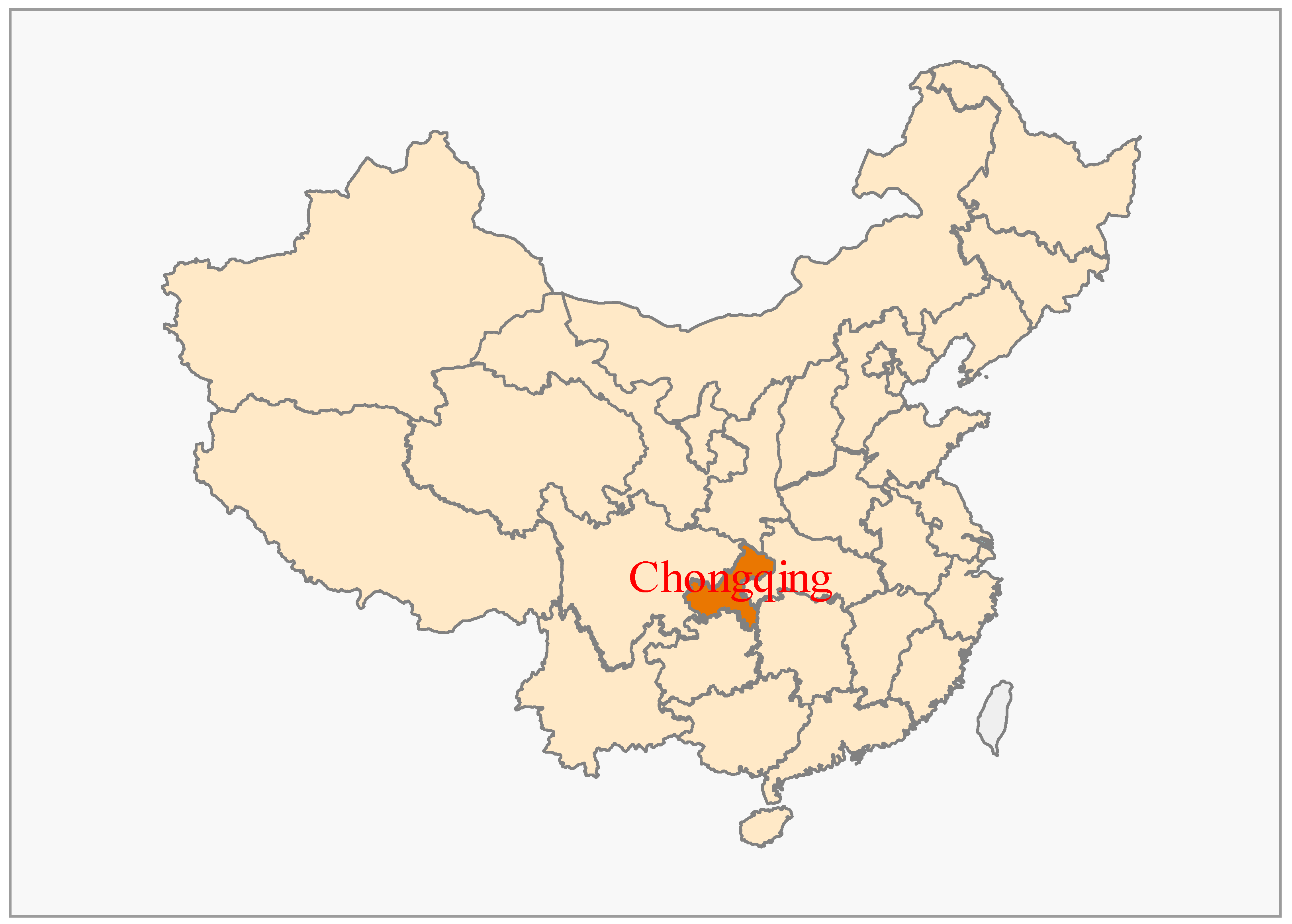
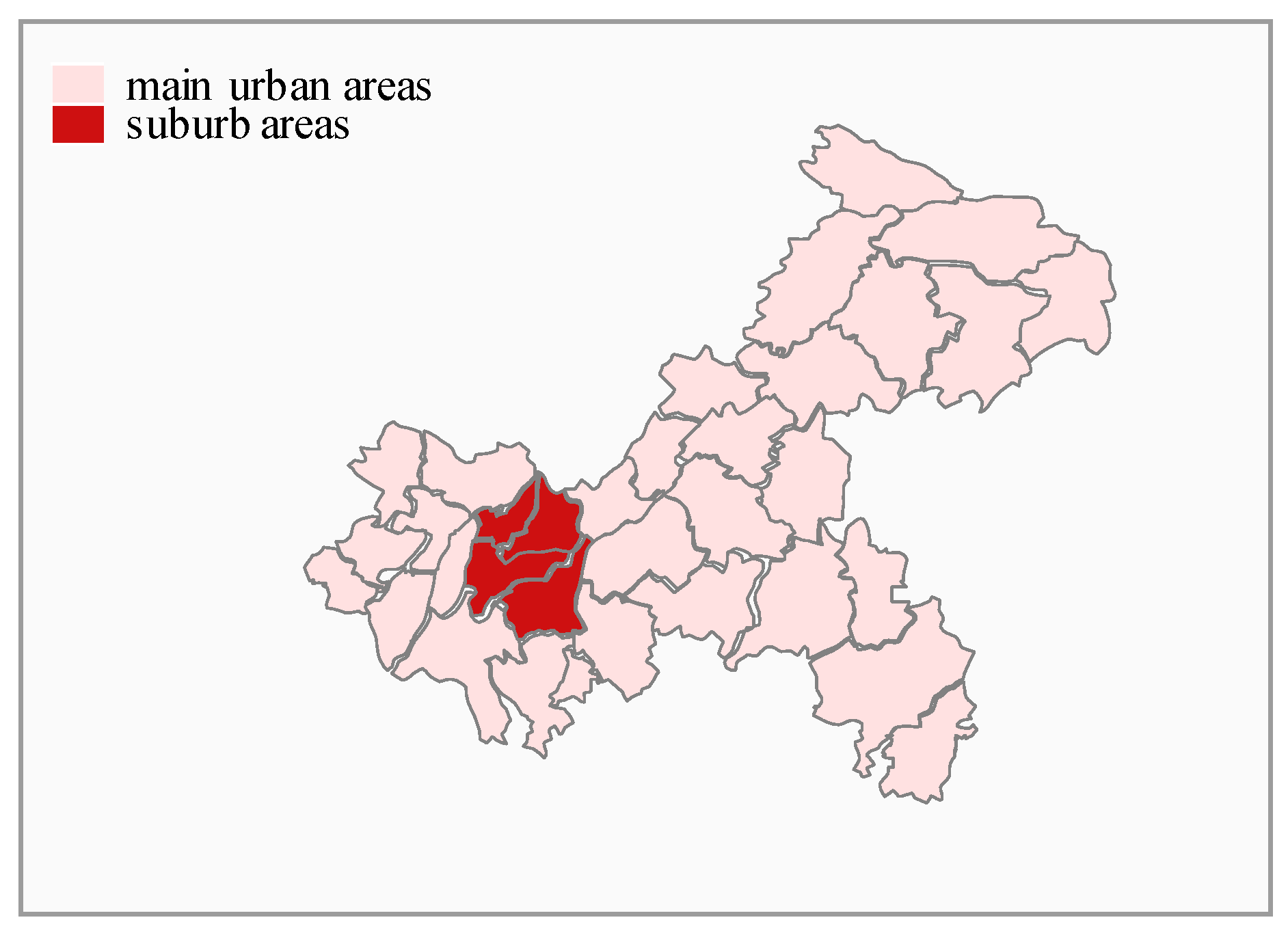
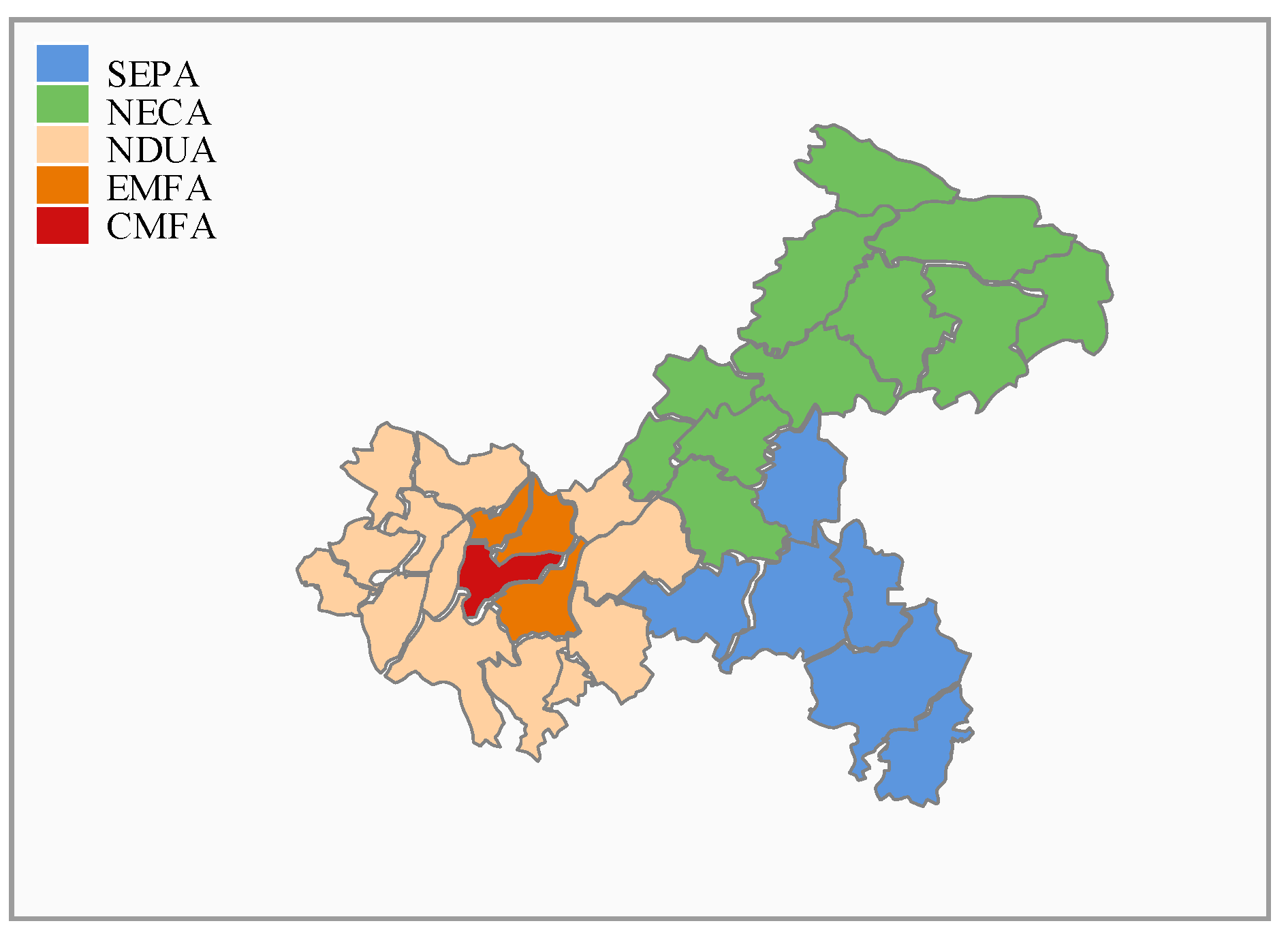
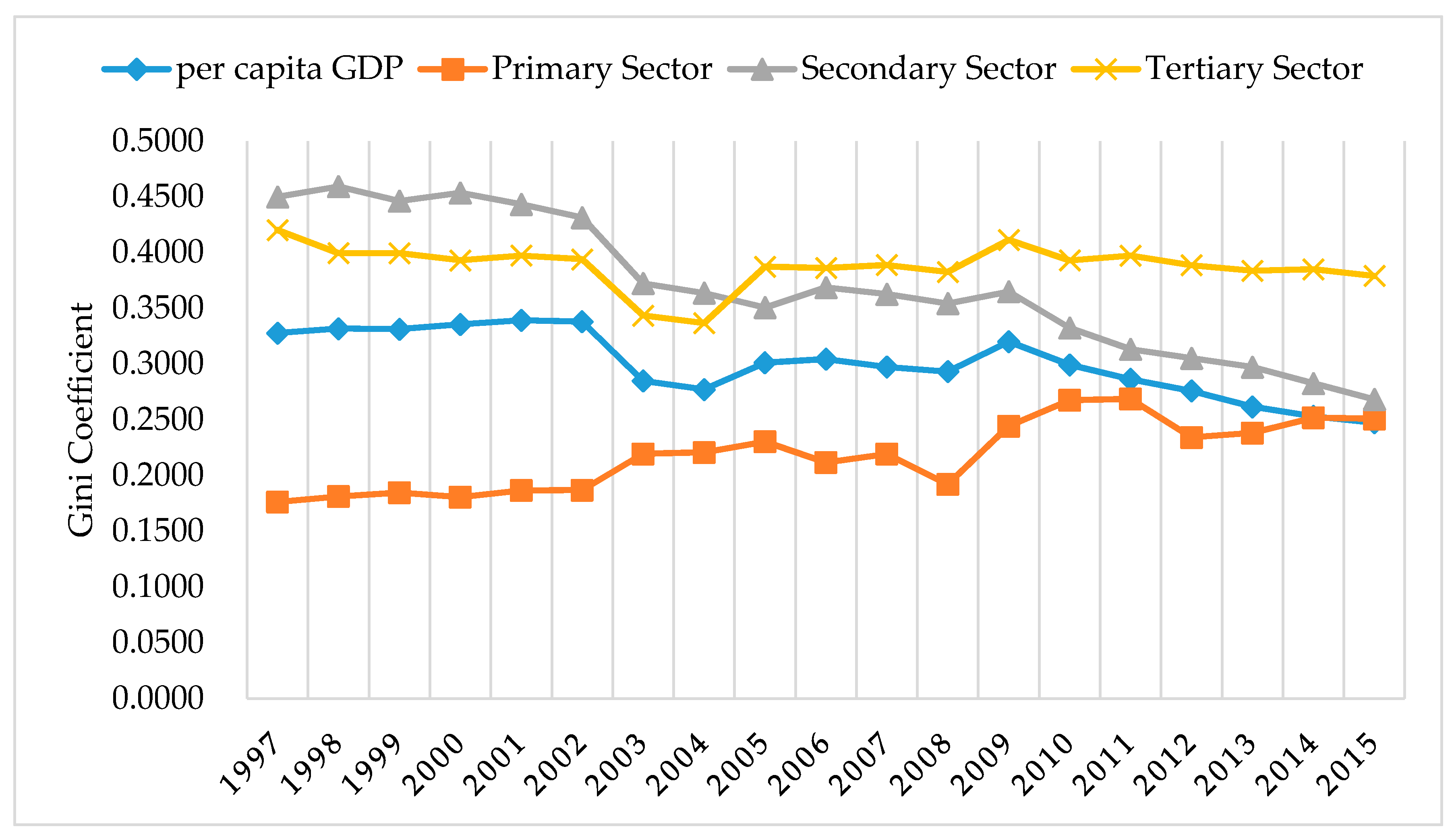
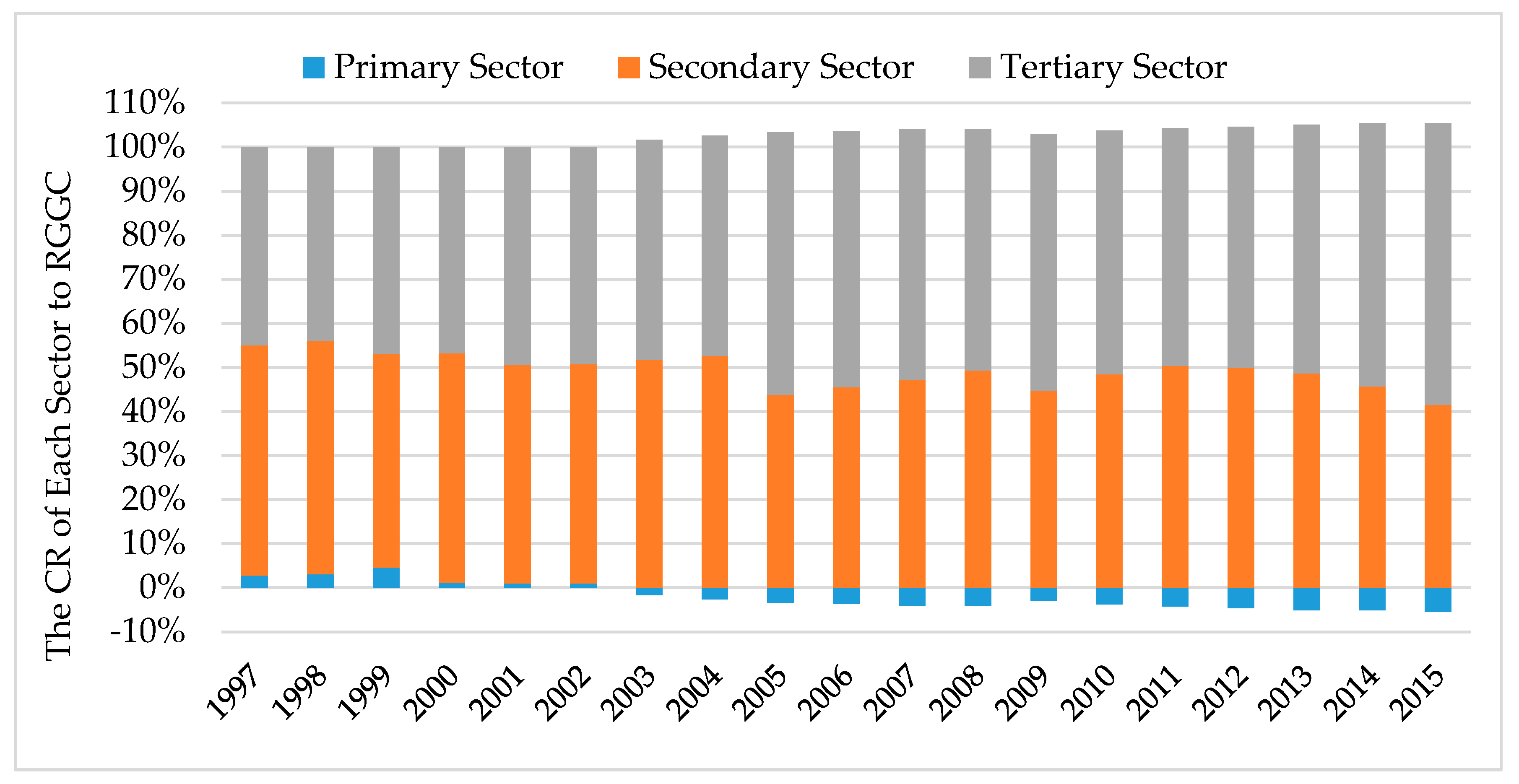

| Year | Main Urban Areas | Suburb Areas | Between Them | Residual Term | ||||
|---|---|---|---|---|---|---|---|---|
| G | CR | G | CR | G | CR | G | CR | |
| 1997 | 0.2345 | 4.62% | 0.2160 | 34.20% | 0.1977 | 60.29% | 0.0030 | 0.90% |
| 1998 | 0.2364 | 4.70% | 0.2128 | 32.86% | 0.2057 | 61.99% | 0.0015 | 0.45% |
| 1999 | 0.2355 | 4.67% | 0.2176 | 33.76% | 0.2028 | 61.20% | 0.0012 | 0.36% |
| 2000 | 0.2359 | 4.67% | 0.2178 | 33.12% | 0.2079 | 61.94% | 0.0009 | 0.27% |
| 2001 | 0.2419 | 4.83% | 0.2196 | 32.72% | 0.2112 | 62.24% | 0.0007 | 0.21% |
| 2002 | 0.2328 | 4.71% | 0.2198 | 32.78% | 0.2110 | 62.38% | 0.0005 | 0.13% |
| 2003 | 0.1762 | 5.39% | 0.2096 | 34.76% | 0.1695 | 59.47% | 0.0011 | 0.39% |
| 2004 | 0.1646 | 5.26% | 0.2057 | 34.88% | 0.1657 | 59.73% | 0.0004 | 0.13% |
| 2005 | 0.1941 | 6.32% | 0.1964 | 28.81% | 0.1947 | 64.63% | 0.0007 | 0.24% |
| 2006 | 0.1775 | 5.92% | 0.2015 | 28.70% | 0.1984 | 65.13% | 0.0007 | 0.24% |
| 2007 | 0.1680 | 5.81% | 0.1988 | 28.93% | 0.1929 | 64.86% | 0.0012 | 0.40% |
| 2008 | 0.1550 | 5.47% | 0.2026 | 29.90% | 0.1884 | 64.22% | 0.0012 | 0.41% |
| 2009 | 0.1477 | 5.06% | 0.2261 | 29.30% | 0.2088 | 65.18% | 0.0015 | 0.45% |
| 2010 | 0.1451 | 5.61% | 0.2254 | 30.83% | 0.1892 | 63.21% | 0.0011 | 0.36% |
| 2011 | 0.1286 | 5.26% | 0.2243 | 32.07% | 0.1784 | 62.26% | 0.0012 | 0.41% |
| 2012 | 0.1382 | 5.97% | 0.2109 | 31.14% | 0.1715 | 62.15% | 0.0020 | 0.73% |
| 2013 | 0.1293 | 5.86% | 0.1965 | 30.81% | 0.1638 | 62.57% | 0.0020 | 0.76% |
| 2014 | 0.1249 | 5.83% | 0.1895 | 30.85% | 0.1584 | 62.54% | 0.0020 | 0.78% |
| 2015 | 0.1444 | 6.97% | 0.1885 | 31.40% | 0.1499 | 60.57% | 0.0026 | 1.06% |
| Year | CMFA | EMFA | NDUA | NECA | SEPA | Between Them | Residual Term | |||||||
|---|---|---|---|---|---|---|---|---|---|---|---|---|---|---|
| G | CR | G | CR | G | CR | G | CR | G | CR | G | CR | G | CR | |
| 1997 | 0.1029 | 0.86% | 0.1874 | 0.41% | 0.0946 | 4.45% | 0.1334 | 2.41% | 0.1370 | 0.23% | 0.2936 | 89.51% | 0.0070 | 2.13% |
| 1998 | 0.0986 | 0.84% | 0.1135 | 0.24% | 0.0882 | 4.02% | 0.1208 | 2.12% | 0.1414 | 0.25% | 0.3010 | 90.69% | 0.0061 | 1.84% |
| 1999 | 0.1117 | 0.95% | 0.1013 | 0.22% | 0.0899 | 4.14% | 0.1274 | 2.21% | 0.1433 | 0.26% | 0.2995 | 90.37% | 0.0062 | 1.86% |
| 2000 | 0.1078 | 0.92% | 0.0973 | 0.20% | 0.0871 | 3.90% | 0.1412 | 2.44% | 0.1620 | 0.28% | 0.3036 | 90.44% | 0.0061 | 1.81% |
| 2001 | 0.1179 | 1.03% | 0.0886 | 0.18% | 0.0892 | 3.92% | 0.1461 | 2.47% | 0.1696 | 0.29% | 0.3064 | 90.28% | 0.0062 | 1.84% |
| 2002 | 0.1069 | 0.95% | 0.0754 | 0.16% | 0.0907 | 3.97% | 0.1473 | 2.50% | 0.1767 | 0.30% | 0.3054 | 90.30% | 0.0061 | 1.82% |
| 2003 | 0.1133 | 1.67% | 0.0507 | 0.14% | 0.0780 | 3.82% | 0.1394 | 2.61% | 0.1608 | 0.31% | 0.2554 | 89.58% | 0.0053 | 1.87% |
| 2004 | 0.1156 | 1.75% | 0.0371 | 0.11% | 0.0661 | 3.32% | 0.1416 | 2.69% | 0.1551 | 0.31% | 0.2499 | 90.09% | 0.0048 | 1.74% |
| 2005 | 0.1406 | 2.18% | 0.0830 | 0.25% | 0.0780 | 3.32% | 0.1468 | 2.48% | 0.1588 | 0.29% | 0.2700 | 89.61% | 0.0056 | 1.87% |
| 2006 | 0.1223 | 1.90% | 0.1011 | 0.33% | 0.0878 | 3.63% | 0.1522 | 2.49% | 0.1668 | 0.29% | 0.2721 | 89.33% | 0.0062 | 2.02% |
| 2007 | 0.1166 | 1.84% | 0.1241 | 0.44% | 0.0947 | 3.99% | 0.1573 | 2.65% | 0.1585 | 0.29% | 0.2625 | 88.24% | 0.0076 | 2.56% |
| 2008 | 0.1051 | 1.66% | 0.1124 | 0.42% | 0.1005 | 4.31% | 0.1752 | 2.99% | 0.1555 | 0.29% | 0.2565 | 87.42% | 0.0085 | 2.91% |
| 2009 | 0.0997 | 1.49% | 0.1414 | 0.55% | 0.1427 | 5.24% | 0.2270 | 3.54% | 0.1453 | 0.24% | 0.2666 | 83.23% | 0.0183 | 5.70% |
| 2010 | 0.1254 | 2.02% | 0.0587 | 0.28% | 0.1262 | 4.88% | 0.2346 | 3.85% | 0.1573 | 0.28% | 0.2482 | 82.90% | 0.0173 | 5.78% |
| 2011 | 0.1207 | 2.01% | 0.0684 | 0.36% | 0.1351 | 5.55% | 0.2259 | 3.83% | 0.1575 | 0.28% | 0.2353 | 82.13% | 0.0167 | 5.83% |
| 2012 | 0.1355 | 2.38% | 0.0798 | 0.45% | 0.1334 | 5.67% | 0.2098 | 3.66% | 0.1531 | 0.29% | 0.2245 | 81.34% | 0.0171 | 6.21% |
| 2013 | 0.1269 | 2.30% | 0.0848 | 0.52% | 0.1289 | 5.89% | 0.1958 | 3.58% | 0.1518 | 0.31% | 0.2127 | 81.25% | 0.0161 | 6.16% |
| 2014 | 0.1174 | 2.18% | 0.0853 | 0.54% | 0.1233 | 5.95% | 0.1911 | 3.57% | 0.1507 | 0.31% | 0.2071 | 81.76% | 0.0144 | 5.69% |
| 2015 | 0.1503 | 2.86% | 0.0824 | 0.55% | 0.1258 | 6.23% | 0.1856 | 3.54% | 0.1518 | 0.31% | 0.1988 | 80.32% | 0.0153 | 6.20% |
| Title | Economic Development | The Change of Shares of Population in Each County |
|---|---|---|
| ΔG | −0.0836 | 0.0031 |
| CR to ΔG | 103.85% | −3.85% |
© 2017 by the authors. Licensee MDPI, Basel, Switzerland. This article is an open access article distributed under the terms and conditions of the Creative Commons Attribution (CC BY) license (http://creativecommons.org/licenses/by/4.0/).
Share and Cite
Ye, X.; Ma, L.; Ye, K.; Chen, J.; Xie, Q. Analysis of Regional Inequality from Sectoral Structure, Spatial Policy and Economic Development: A Case Study of Chongqing, China. Sustainability 2017, 9, 633. https://doi.org/10.3390/su9040633
Ye X, Ma L, Ye K, Chen J, Xie Q. Analysis of Regional Inequality from Sectoral Structure, Spatial Policy and Economic Development: A Case Study of Chongqing, China. Sustainability. 2017; 9(4):633. https://doi.org/10.3390/su9040633
Chicago/Turabian StyleYe, Xiaosu, Lie Ma, Kunhui Ye, Jiantao Chen, and Qiu Xie. 2017. "Analysis of Regional Inequality from Sectoral Structure, Spatial Policy and Economic Development: A Case Study of Chongqing, China" Sustainability 9, no. 4: 633. https://doi.org/10.3390/su9040633





